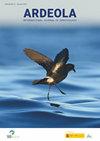出轨的骗子:社会一夫一妻制,但基因一夫多妻制在一窝寄生虫
IF 1.2
4区 生物学
Q2 ORNITHOLOGY
引用次数: 2
摘要
了解交配系统的可变性是动物行为研究的核心。基因技术的出现使社会和基因数据得以结合,为生殖策略提供了更全面的观点。在专性禽类寄生虫中,由于缺乏来自后代照顾的限制,交配系统可以根据社会生态条件的变化而具有很大的可塑性。这种种内变异的潜力使寄主幼虫成为研究生殖行为进化的理想模式物种。本研究首次采用无线电追踪、野外行为观察和遗传亲本分析相结合的方法,研究了大斑布谷鸟(Great Spotted Cuckoo Clamator glandarius)繁殖的社会和遗传模式。我们的研究结果表明,尽管这种物种具有高度的遗传一夫多妻制和缺乏领地性,但松散的配对关系仍然可以维持,这可能是因为需要配对内的合作来寻找和寄生其大型宿主(腐肉乌鸦Corvus corone和欧亚喜鹊Pica Pica)的巢穴。我们还发现,杜鹃大多在合适的觅食地附近活动,但雌性杜鹃会移动更远的距离来寻找寄主的巢穴。将我们的研究结果与先前关于不同种群的报告进行比较,也表明大斑杜鹃的领土行为具有可塑性,这可能取决于种群密度、宿主选择和宿主巢穴的分布。——bolopo, D., Roncalli, G., Canestrari, D.和Baglione, V.(2020)。不忠的骗子:社会一夫一妻制,但寄生虫的基因一夫多妻制。《农业科学》,67:39-56。本文章由计算机程序翻译,如有差异,请以英文原文为准。
Cheating Cheaters: Social Monogamy but Genetic Polygamy in a Brood Parasite
Understanding the variability of mating systems is central in the study of animal behaviour. The advent of genetic techniques allowed combining social and genetic data, providing a more comprehensive view of reproductive strategies. In obligate avian brood parasites, the lack of constraints derived from offspring care allows for great plasticity of the mating system in response to changes in socio-ecological conditions. This potential for intraspecific variation makes brood parasites ideal model species to investigate the evolution of reproductive behaviour. We simultaneously studied for the first time social and genetic patterns of reproduction of the Great Spotted Cuckoo Clamator glandarius, combining radio-tracking and behavioural observations in the field with genetic parentage analyses. Our results reveal that loose pair bonds can be maintained in this species despite high levels of genetic polygamy and lack of territoriality, possibly because of the need of intra-pair cooperation for finding and parasitising the nests of its large hosts: the Carrion Crow Corvus corone and the Eurasian Magpie Pica pica. We also found that cuckoos mostly ranged around suitable foraging grounds, but females moved larger distances to find host nests to parasitise. Comparison of our results with previous reports on different populations also suggests a plasticity of Great Spotted Cuckoo territorial behaviour that may depend on population density, host choice and distribution of host nests.—Bolopo, D., Roncalli, G., Canestrari, D. & Baglione, V. (2020). Cheating cheaters: social monogamy but genetic polygamy in a brood parasite. Ardeola, 67: 39-56.
求助全文
通过发布文献求助,成功后即可免费获取论文全文。
去求助
来源期刊
CiteScore
2.30
自引率
6.20%
发文量
16
审稿时长
>12 weeks
期刊介绍:
Ardeola: International Journal of Ornithology is the scientific journal of SEO/BirdLife, the Spanish Ornithological Society. The journal had a regional focus when it was first published, in 1954. Since then, and particular during the past two decades, the journal has expanded its thematic and geographical scope. It is now a fully international forum for research on all aspects of ornithology. We thus welcome studies within the fields of basic biology, ecology, behaviour, conservation and biogeography, especially those arising from hypothesis-based research. Although we have a long publication history of Mediterranean and Neotropical studies, we accept papers on investigations worldwide.
Each volume of Ardeola has two parts, published annually in January and July. The main body of each issue comprises full-length original articles (Papersand Review articles) and shorter notes on methodology or stimulating findings (Short Communications). The publication language is English, with summaries, figure legends and table captions also in Spanish. Ardeolaalso publishes critical Book Reviewsand PhD-Dissertation Summaries; summarising ornithological theses defended in Spain. Finally there are two Spanish-language sections, Ornithological News; summarising significant recent observations of birds in Spain, and Observations of Rare Birds in Spain, the annual reports of the Spanish Rarities Committee.

 求助内容:
求助内容: 应助结果提醒方式:
应助结果提醒方式:


